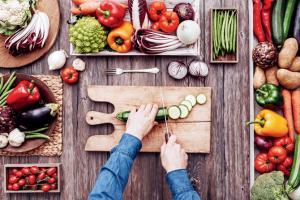What happens when the principles of jugaad are applied to vegetables never seen before?

Like any Indian cook, Kalika had the spirit of jugaad hard-wired into her brain
 Every time I return to Bangkok from Mumbai, I carry a few more kilograms than when I came, and they're all vegetables. Specifically, the smuggled vegetables are suran, tondli and arbi. If I see any parwal, I have been known to pick up a few, to fry them later in mustard oil to make potol bhaja, Bengali style.
Every time I return to Bangkok from Mumbai, I carry a few more kilograms than when I came, and they're all vegetables. Specifically, the smuggled vegetables are suran, tondli and arbi. If I see any parwal, I have been known to pick up a few, to fry them later in mustard oil to make potol bhaja, Bengali style.
For reasons best known to Bangkok, the city celebrated as the world's street food capital does not have the items mentioned above. Never mind that it has a large and influential population of Persons of Indian Origin, many of them now prosperous and tax-paying citizens. Mind you, you can find pretty much anything else from any other part of the world that you fancy in Bangkok - jicama, habañero chillies, Sichuan red pepper, salsify, Brussels sprouts, Cumberland sausages, Brie cheese with truffles, alphabet shaped pasta, shudh ghee, yea, even kasuri methi. But in Asok Market, on Sukhumvit, where many Indians get their curry leaves, hard-shell coconuts and plantain stems, you will not see my four favourite vegetables.
Here's something else you won't see in Thailand - in a city overflowing with cosmopolitan ingredients, you will not see new recipes emerging from cross-cultural culinary marriages. Thais do not experiment with their food. You are unlikely to meet a Phad Thai with melted Gruyère cheese topping or a Hainan chicken served with a parsley-flavoured bouillon.
It was a thrilling moment for kitchen hogs like me when India opened its doors to global ingredients in the 1990s. Capsicum, which had always been green, was suddenly spied sitting next to its mango yellow and crimson cousins. Parsley could be bought from the same bai who sold you dhaniya. Broccoli, zucchini and mushrooms began showing themselves; celery and parsley hid nervously behind spinach in a Pali Hill vegetable basket. Rumour had it that there were chaps on Warden Road and Crawford Market who openly displayed kaffir lime leaves, lemon grass and galangal.
Change really started when legendary adman Ravi Gupta, ignoring his friends' advice to quit being quixotic, set up Trikaya Agriculture around Talegaon, convinced that he could charm cold-weather high-altitude vegetables into growing out of nearly sea-level summer soil. But his fingers must have had very green magic, because his plants broke all the rules: somehow even iceberg lettuce grew in summer on hot fields and he supplied tons of it to McDonalds, which had just entered India.
Of course, no one wanted any of this nonsense. Broccoli was dismissed as wannabe cauliflower, and leeks as spring onions that didn't make it. Since Ravi liked the process more than its monetisation, nothing happened until he passed on to the great gardener in the sky and his market-savvy son Samar took the helm.
But my interest was in the women workers of Trikaya, the first to set eyes on these then-exotic vegetables. In a good year, Kalika, a picker, was saying hello to dozens of vegetables that have no Indian names and probably still don't - avocado; artichoke; broccoli; bak choi; leeks; fennel; rhubarb; red cabbage. Every day she got to take home a few vegetables that were bruised or rejected for some other reason.
Like any disruptive Indian cook, Kalika had the spirit of jugaad hard-wired into her brain. I had the honour of watching her figure out the first zucchini she had ever seen. It looked like a cucumber, dark green variety, except for the topknot left over from the parent plant. Cut it, and the inside reminded her of another vegetable - dudhi? Bottle gourd, you know? So could it be eaten raw, like the cucumber, or should she assume that it was neutral like the dudhi, ready to absorb the flavours allotted to it during cooking?
Questions, questions, questions, but Kalika was already applying principles learnt in the Satara kitchen of her childhood. First she chopped the zucchini into small pieces; a half-fistful of chana dal had been soaking nearby for three hours.
Some jeera and mustard seeds were added to smoking oil, and as they crackled and popped, she introduced a paste of coarsely pounded chopped onions, green chillies, ginger and grated coconut. Shortly, the nicely swollen chana dal went in; salt and chilly powder were added. As the aromas filled the kitchen, in went the zucchini. A few minutes later, it was ready - and an ordinary, unknown Maharashtrian woman had invented a brand new dish with a never-before vegetable for the first time in the known universe. Right towards the end, almost as an afterthought, she crumbled some peanuts over it.
In today's lunatic food world of India, Kalika would be called a fusion chef. Someone would serve a tablespoon of her creation in the middle of a giant plate and call it molecular cuisine.
Here, viewed from there. CY Gopinath, in Bangkok, throws unique light and shadows on Mumbai, the city that raised him. You can reach him at cygopi@gmail.com Send your feedback to mailbag@mid-day.com
Catch up on all the latest Mumbai news, crime news, current affairs, and also a complete guide on Mumbai from food to things to do and events across the city here. Also download the new mid-day Android and iOS apps to get latest updates
 Subscribe today by clicking the link and stay updated with the latest news!" Click here!
Subscribe today by clicking the link and stay updated with the latest news!" Click here!









